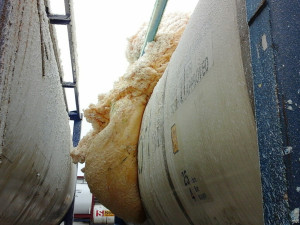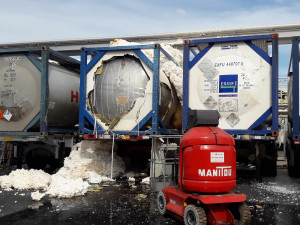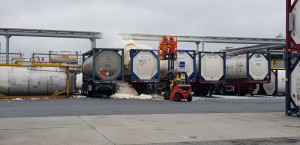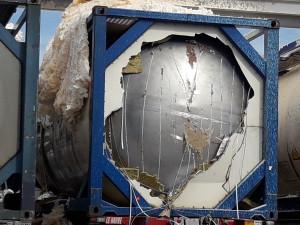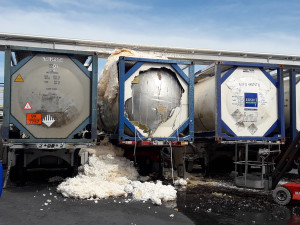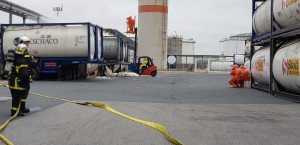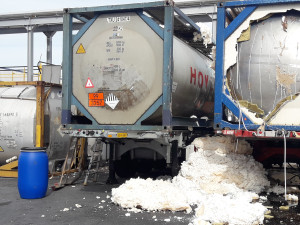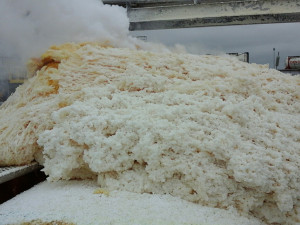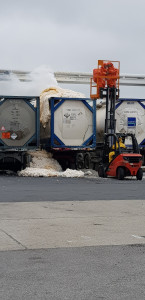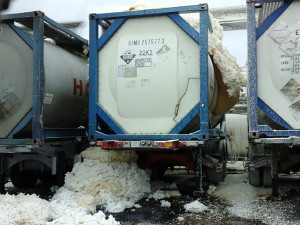Methacrylic acid is corrosive, harmful and flammable.
Uninhibited, it can polymerise vigorously and explosively (exothermic reaction).
Even in its inhibited state, it is sensitive to heat and can polymerise if overheated.
Polymerisation can also be caused by oxidising substances, solar radiation or corrosion of the storage container (presence of metal ions).
At around 8:50 p.m., a methacrylic acid vapour leak occurred in a company specialising in cleaning containers and trucks containing chemical products. The acid leaked through the valve of a 24,000-litre insulated tanker parked on the site. Large plumes of white smoke were released intermittently, and a security perimeter was established. The personnel of neighbouring companies confined themselves while the temperature measured on the tank wall reached 140 °C. Firefighters injected water through the tank’s heating coils to cool it down. They deployed a water curtain and a hose to limit the dispersion of the product into the atmosphere. The sewer system was closed off, and the liquid effluents were recovered on site.
An examination by INERIS’ emergency support unit (French National Institute for Industrial Environment and Risks) and the network of mutual assistance for managing accidents involving hazardous materials was called for. Explosimetry, temperature and VOC measurements were conducted regularly.
The following day, the temperature on the tank’s wall reached 72 °C at 8:00 a.m. and 55 °C at 10:00 a.m. As the product cooled, it polymerised upon leaving the valve, forming a large layer on the tank’s surface. A continuous plume of vapour continued to be released. The polymers may have prevented the remaining vapours from exiting the valve, causing a pressure build-up with the risk of pneumatic rupture and then followed by fire. An attempt was made to remove some of the polymer from the dome with a nozzle to clear the valve, and this proved unsuccessful as the polymer was very hard.
The day after that, part of the insulation was removed to improve temperature dissipation. The floor was cleaned, and the fire brigade left the site at around 6 p.m. Only a thin plume of smoke remained. The operator continued to monitor the area. Two tonnes of the product had been released.
On the evening of the third day, emissions had stopped, and the temperature inside the tank dropped below 50 °C, allowing it to be handled. The tank was moved to an isolated area and placed under a scaffold structure covered with canvas to avoid contact with rainwater. The polymer waste and the container wash water were treated by incineration. Reheating activity resumed except for the containers containing hazardous products.
The tank was being reheated at the time of the incident, and the cause of the leak was attributed to overheating the tank due to a handling error. An operator had introduced steam instead of hot water into the reheating circuit. This was attributed to a hose connection error facilitated by a lack of visual differentiation between the two. The pressure then rose inside the tank, resulting in product release after the safety valve, set at 4 bar, was opened.
To prevent this from happening again, the operator modified the reheating procedure and provided training for all employees. Before each reheating operation, a temperature sensor is inserted into the container. The reheating process cannot be initiated until the operator has entered into the console the product being reheated and the temperature thresholds to be reached and not exceeded. The customers’ target temperatures are checked for consistency with the safety data sheets (SDS). If a threshold is exceeded, an employee is informed and can switch off the heating remotely. If there is a fault on the automatic reheating system, a boiler breakdown or an electrical failure, the reheating process is automatically switched off and cannot be restarted without local acknowledgement. The temperature of the reheated products is recorded three times a day, and the temperature sensors are checked every six months.
In addition, the operator has established a colour coding system to differentiate between the steam and water systems. A double-checking procedure is performed on Friday evenings by an on-call operator and a team leader.
A toxic release had already occurred on the site in 2009 (ARIA 36104).



